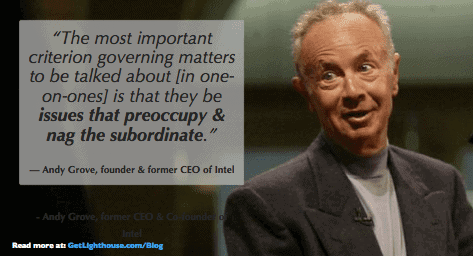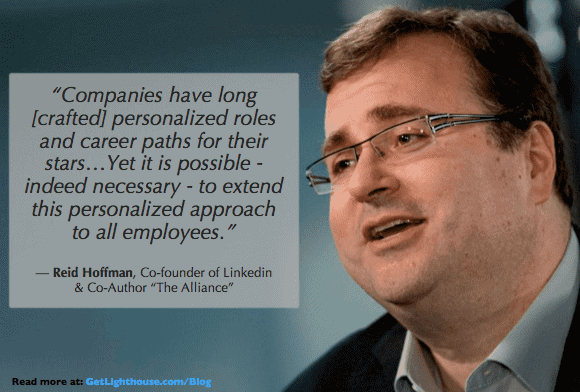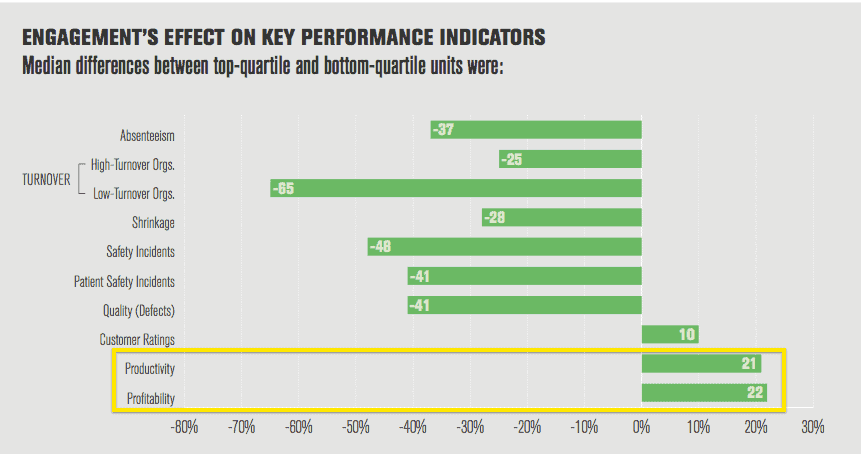What separates a good manager's habits from a bad one? What goes into consistently, great 1 to 1 meetings?
Why are there so many bad managers, and bad 1 to 1 meetings happening?
These questions and more were the topics of discussion on the great podcast we were interviewed on, Entelo's Hiring on All Cylinders, hosted by Rob Stevenson.
We covered a ton of ground in the interview as you can listen to below. To help you make the most of it, we broke down the key points discussed with links to further reading, and the charts we talk about during the show. Enjoy!
Key Takeaways & Talking Points on 1 to 1 meetings from Lighthouse on Hiring on All Cylinders
Since a picture is worth a thousand words, below are some of the best takeaways, and visuals we referenced as you listen to the podcast.
Have questions or follow up thoughts on what you hear? Leave a comment and we'll be sure to answer it or integrate it into our recap here.
1) Avoid Status Updates in your 1 to 1 meetings
We've talked about this many times on the Lighthouse blog, and for anyone looking to make the most of their 1 to 1 meetings, it bears repeating: status updates have no place in them.
Loni, a manager at Entelo on the show with us, helps bring some great nuance to this concept.
You never want to be getting basic project updates from team members that everyone else on the team would benefit from hearing. However, if you spend much of your time coaching them on skills, tasks, and approaches that will help them do their work better, then that's a great use of your 1 to 1 meetings.
Further reading: See our full post here on why status updates should never be part of your 1 on 1s.
2) Mix up your 1 to 1 meetings
If you're not careful, it's easy for your 1 to 1 meetings to get stale. You may cover the same topics or handful of questions each time. This makes it easy to fall into a rut and leave too many things unspoken.
Once again, Loni sets a good example. She shares how she mixes her meetings up and makes her 1 to 1 meetings once a month a totally different experience for her team members. This ensures important things are not missed, and the meetings stay valuable.
Further Reading: If you're a manager trying to think about what to cover in your 1 to 1 meetings, these are great potential topics:
- Their long term career goals
- Ideas for improving the company or your team
- Ways they can improve or areas they'd like feedback from you
- Feedback from them on how you can improve
- Building rapport and relationship that shows you care about them
- Their work habits, and ways to improve them
- Shopping ideas to get buy in and big changes to understand their concerns
3) Grow your people
We have talked about this many, many times here on the Lighthouse blog, too. The top perk people want at work, and a key part of retention, is helping grow your team members.
Loni has a great suggestion of a way to accomplish this. In addition to discussing growth in her 1 to 1 meetings, she uses 20% projects to make it happen. They're a great way to grow skills and adjust the job as people continue to work at your company.
By making some of their growth 20% projects, it's lower risk; if they find they don't like something, it's easier to change these projects than if they had made a bigger commitment.
Further Reading: We highly recommend Reid Hoffman's book, The Alliance we talked about on the show and these posts can help you, too:
- 3 Great approaches to talking about goals with your team
- What to do if your team member doesn't know what their goals are
- How to grow your people when you can't promote them
5) Try skip level 1 on 1s
As you rise in your organization, it's easy to wake up one day and realize you're managing people who are also managers. At this point, you're disconnected from a lot of day to day activity, which can make it hard to feel in the loop and always make the best decisions.
One of the key tools great leaders use to ensure their managers are doing a good job with their teams, and keep a pulse on the front lines, is to have skip level 1 on 1 meetings. These are like other 1 to 1 meetings, except they're less frequent (usually every 6-12 weeks) and with people another layer down in the organization.
Further Reading: We mentioned an amazing profile of Airbnb CEO Brian Chesky, who does something like skip level 1 to 1 meetings. You can read the Fortune profile here.
5) Seek out good role models
Dilbert, Office Space, and the Office all have one thing in common: they're bad examples of leadership in a work environment. Unfortunately, for many people, they don't have many good role models to emulate in their workplace, nor in popular culture.
Is it any wonder young and inexperienced managers struggle?
Making matters worse, if you're struggling, you're dis-incentivized to ask for help; do you want to admit to your boss, or HR, you are having a hard time leading your team? Why risk it?
Further reading: The most powerful way to lead is by the example you set, which you can read more about here. The world needs more positive examples.
6) Build rapport with those you manage
Your team won't come to you, or open up when you ask them questions unless you've built some rapport and trust with them. They have to know you care and see that you follow through on what you talk about in your 1 to 1 meetings.
All you need is one or two things to click and connect on and then you'll be on your way. You never know what you may share in common until you talk about it.
For example, would you expect a 60 year old, white NFL head coach would have anything in common with his mixed-race, troubled draft pick? Turns out, they had an essential one, which this great clip highlights.
Further Reading: Want to learn more about building rapport with your team? Here's a great place to start:
- Why experts agree you need to build rapport with your team
- 81 ways to build rapport with anyone you manage or work with
7) Good managers read the signs
Wouldn't it be great if your team always just came right out with it when they had problems or something bothering them?
Unfortunately, that's not how it works. Often, people will wait a long time to bring things up, or not at all. As a manager, it's your job to look for signs and to then probe for issues.
The key is to strike a balance of digging in when you think there's a problem, and not being overbearing and reading into things that aren't there.
The best ways to do this is to look for a few signs before you take any action, and use your 1 to 1 meetings to take a pulse. Asking a few questions is a great way to start, and then if your instincts tell you to keep probing, push further.
Further Reading: As a manager, understanding body language is a super important skill. The book, "What Every Body is Saying" by a retired FBI agent is a fun and helpful read we highly recommend on this subject.
8) The value of doing these things
So why put in all this effort as a manager? Making time to meet with each of your team members on a regular basis every week or month is a major commitment.
When you think about all the things we've talked about that you should cover in your 1 to 1 meetings, ask yourself a simple question: is there any other time you're likely to cover these things? Your answer is almost certainly that there is no other time.
The good news is that if you make the time, and invest it well, you'll be helping to better engage your team. And when you do, you get the kinds of benefits in the chart above from Gallup.
The final two, profitability and productivity, are the most interesting. With 20%+ gains in profitability and productivity, if you have a team of 5, you can essentially gain the benefits of another team member simply by engaging everyone on your team.
Further Reading: Want to be sure everyone on your team is engaged? Here's 2 great places to start:
- Gallup's State of the American Manager study and results managers need to know
- Why people quit managers, not companies, and what to do about it
9) Use 5 Why's Root Cause analysis
Don't just take things at surface value in your 1 to 1 meetings. Take some time to dig in.
One of my favorite methods, and one I demonstrated with Rob in the podcast, is 5 Why's Root Cause Analysis. Basically, rather taking first level answers as the end of a topic, you keep going. Ask "why?" and "Tell me more about that..." until you feel like you really get to the bottom of the subject and truly understand their thoughts on it.
Asking good questions is a key skill to being a good manager. The more you can hone that ability, the more valuable, productive insights you'll learn in your 1 to 1 meetings.
Further Reading: If you're thinking about how to develop your skills and approach asking good questions, here's a few places to start:
- A manager's most important, yet overlooked management skill to learn
- Ben Horowitz on a manager's skill in asking questions
- 101 Questions to ask in 1 on 1s for ICs, and 96 Questions to ask managers
10) Understand the divide between what makes you happy and stay, vs unhappy and quit
Adding more perks does not make people stay at your company. As Rob remarked on the podcast, "No one stays for the ping pong tables."
This is a crucial concept to understand, which is why above we've included the chart I mentioned.
In the 1950s and 60s, Frederick Herzberg studied what motivated and retained people at work. What's fascinating is he found that what makes you want to quit is different than what makes you want to stay.
When you look at the chart above, you can see that the dissatisfaction items are very different from the items that contribute to deep satisfaction. Keep that in mind as you work with your team, and especially want to motivate and retain your best people.











